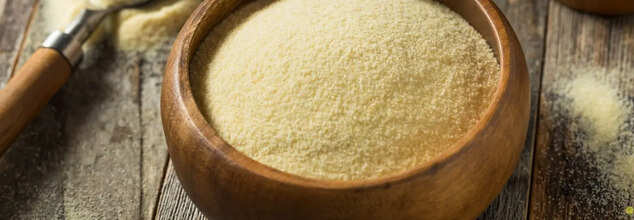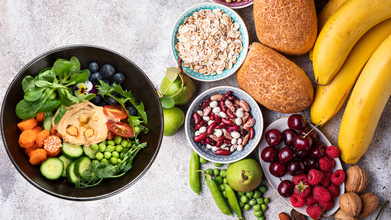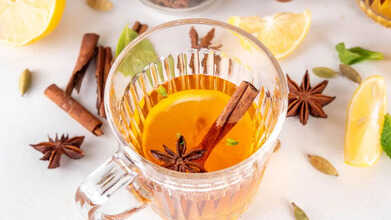- Health Conditions A-Z
- Health & Wellness
- Nutrition
- Fitness
- Health News
- Ayurveda
- Videos
- Medicine A-Z
- Parenting
Why Should You Add Semolina To Your Everyday Diet?

Semolina (Credit: Canva)
Semolina is a coarse flour made from durum wheat—a type of hard wheat. Compared to the all-purpose flour, it has a darker and deeper golden colour along with mild, earthy aroma. Along with its culinary uses, semolina also benefits weight management, heart health, and your digestive system.
How Nutritious Is Semolina?
While semolina itself is nutrient-rich, it can be enriched by manufacturers. It means that nutrients that were lost during the processing of durum wheat can be re-added. Enriched semolina contains higher levels of vitamins and minerals than unenriched alternatives.
A 1/3-cup (56-gram) serving of uncooked, enriched semolina provides:
- Calories: 198
- Carbs: 40
- Protein: 7
- Fat: less than 1
- Fiber: 7% of Reference Daily Intake (RDI)
- Thiamine: 41% of RDI
- Folate: 36% of RDI
- Riboflavin: 29% of RDI
- Iron: 13% of RDI
- Magnesium: 8% of RDI
What's The Big Deal About Semolina?
1. May Aid Weight LossSemolina is a nutrient-dense food that can support weight loss. A 1/3 cup (56 grams) of uncooked, enriched semolina contains 7% of the recommended daily intake (RDI) for fibre, which helps reduce hunger and prevent weight gain. Research suggests a fiber-rich diet is linked to weight loss and improved body composition. Additionally, semolina provides over 7 grams of protein per serving, which aids in reducing appetite, preserving muscle mass, and enhancing fat loss.
2. Promotes Heart Health
Rich in fibre, folate, and magnesium, semolina supports cardiovascular health. There is empirical evidence that suggests that fibrous food items reduce LDL (bad) cholesterol and inflammation, in turn, cutting down heart disease risk by up to 24%.
Other nutrients like folate and magnesium in semolina further enhance heart health, with magnesium-rich diets linked to reduced risks of heart failure and stroke.
3. Helps Control Blood Sugar
Semolina’s magnesium and fibre content makes it a smart choice for managing blood sugar. Magnesium improves insulin sensitivity, reducing the risk of type 2 diabetes by up to 14%, while fibre slows carbohydrate absorption, preventing blood sugar spikes. Diets high in fiber can also lower fasting blood sugar and haemoglobin A1c levels in people with diabetes.
4. Excellent Source of Iron
Semolina provides 13% of the RDI for iron in a 1/3 cup serving, making it a valuable addition to preventing iron-deficiency anemia. Although it contains non-heme iron, which is less easily absorbed, pairing semolina with vitamin C-rich foods like tomatoes or citrus can enhance iron absorption.
5. Supports Digestive Health
Semolina's fiber content benefits digestion by encouraging the growth of beneficial gut bacteria, which support digestion, immunity, and metabolism. Fibre also promotes regular bowel movements and may help alleviate constipation, with studies showing significant improvements in symptoms from increased whole-grain fiber intake.
Ways To Incorporate Semolina In Your Everyday Diet?
Due to its rich, earthy taste semolina is one of the easiest ingredients to include in your everyday diet. You can use it to make dishes like upma, halwa, idlis, or even add it to soups and stews to thicken them. You can also use it as a substitute for regular floor to make a range of dishes like pasta, cakes, and cookies.
A Longevity Expert Who Studies 'Super Agers' Eats All THIS In A Day

Credits: Canva
What does it actually take to eat your way into old age with your health intact. According to cardiologist and longevity researcher Eric Topol, it has far less to do with rare genes and far more to do with everyday food choices made consistently over decades.
Topol, author of Super Agers: An Evidence-Based Approach to Longevity, has spent years studying people who live well into their 80s, 90s and even past 100 without developing major chronic illnesses such as heart disease, cancer or neurodegenerative disorders. In an interview with The Washington Post, he explained that his research at the Scripps Research Translational Institute followed more than 1,400 adults aged between 80 and 105 who had avoided these conditions altogether. Genetics, surprisingly, played only a minimal role. Lifestyle, especially diet, did the heavy lifting.
Why genes matter less than daily habits
For Topol, eating for longevity means sticking closely to an anti-inflammatory, Mediterranean-style diet. His plate is built around vegetables, fruits, legumes, nuts, seeds, olive oil and fish, with poultry appearing occasionally. Red meat, however, has been absent from his diet for roughly 45 years. That decision began as a family choice and was reinforced by early evidence linking red meat consumption to cancer risk, particularly relevant given his family history of colon cancer.
The consistency of this approach matters. The Mediterranean diet remains one of the most studied eating patterns in the world, with strong evidence linking it to lower inflammation and reduced risk of chronic disease.
Read: 7 Science-Backed Tips For Healthy Aging, According To Cardiologist
A predictable, protein-rich breakfast
Topol’s days begin early, around 5 am, and breakfast is almost ritualistic. A large bowl of non-fat Greek yogurt forms the base, topped with blueberries, strawberries or both, and finished with a small amount of low-sugar granola. It is simple, repeatable and something he genuinely looks forward to, which he believes matters more than novelty when it comes to sustaining healthy habits.
Nuts for lunch and hydration as a strategy
Lunch is deliberately light. Instead of a full meal, Topol relies on a homemade mix of walnuts, almonds and peanuts. It is filling, nutrient-dense and easy to fit into a busy workday. When lunch becomes social, he gravitates toward salads, occasionally adding crackers or pretzels.
Nuts are his favorite food, even though a history of kidney stones forced him to be mindful of hydration due to their oxalate content. His solution is aggressive fluid intake, especially fizzy water, which allows him to continue eating these foods without triggering problems.
The big salad that anchors dinner
Dinner is the most substantial meal of the day. A large salad made with lettuce and arugula is layered with carrots, tomatoes and avocado. Several times a week, baked salmon or another fish is added on top. The dressing is minimal, just olive oil and balsamic vinegar. Sometimes he adds crumbled blue cheese, Gorgonzola or seasonal corn for variety.
The meal is quick to prepare, deeply satisfying and so central to his routine that skipping it leaves him feeling noticeably off.
Calories, fasting and mindful indulgences
Topol generally eats around 1,500 to 1,600 calories a day and avoids eating late at night, aiming for a roughly 12-hour overnight fast. If hunger strikes early in the evening, he keeps it simple with dried fruit, a few nuts or an occasional low-calorie cookie.
There are foods he avoids keeping at home altogether. Tortilla chips test his willpower, and most commercial ice creams are too heavily processed for his comfort.
What he tells patients about eating better
In his clinic, Topol begins diet conversations by asking patients exactly what they eat across the day. Many are unaware of how much sugar, alcohol or excess protein they consume, often assuming these habits are normal. His advice is steady and evidence-based. Eat mostly whole foods, prioritize plants and fish, hydrate well, limit ultra-processed products and pay attention not just to what you eat, but when you eat it.
Want To Slow Ageing? Cutting Back On This One Food Could Help You Live Longer

Credits: Canva
It is widely accepted that what we eat shapes how we age, but new research suggests sugar may be one of the strongest drivers of faster ageing at the cellular level.
Using an advanced method known as the “epigenetic clock,” researchers uncovered a clear link between added sugar intake and the speed at which cells begin to show signs of ageing. The findings point to sugar as a key factor in biological ageing, even among people who otherwise eat well.
What Is The Epigenetic Clock?
The “epigenetic clock” is not a futuristic idea. It is a scientific tool that examines chemical changes in DNA to estimate biological age, which reflects the condition of cells rather than the number of years a person has lived.
For this study, scientists followed 342 women in midlife. They analysed dietary patterns and measured biological age using DNA samples collected from saliva, allowing them to compare what participants ate with how quickly their cells appeared to age.
Can Sugar Speed Up Cellular Aging?
The results showed a consistent pattern. Every gram of added sugar consumed was linked to a measurable increase in biological ageing. This effect appeared even in participants who followed generally healthy diets, suggesting sugar has an independent impact on cellular health. In contrast, diets lower in added sugar and richer in nutrients were associated with slower ageing at the cellular level.
Sugar And Longevity
Researchers observed that participants who consumed fewer added sugars tended to have a younger biological age. The strongest protective effects were seen in those whose diets focused on whole foods, fibre, and essential vitamins and minerals. These findings suggest that small dietary changes could influence long-term health and longevity.
Cutting Back On This One Food Could Help You Live Longer
- Cut the sugar, turn back time: Reducing added sugar intake by just 10 grams a day, roughly the amount found in a typical granola bar, was linked to a potential reversal of biological ageing by up to 2.4 months.
- Nutrient-rich diets for the win: Diets high in vitamins A, C, and E, along with magnesium and fibre, were strongly associated with a younger biological age.
- Mediterranean magic: Mediterranean-style diets, known for their anti-inflammatory and antioxidant properties, showed the strongest link to slower cellular ageing.
Excess Sugar Harms Cellular Health
High sugar intake contributes to chronic inflammation, oxidative stress, and damage to DNA, all of which place strain on the body’s cells. While the occasional sweet treat is unlikely to cause harm, regularly consuming large amounts of sugar can gradually interfere with the body’s natural repair systems.
Over time, this damage may accelerate ageing and increase the risk of chronic disease.
Simple Sugar Swaps To Try
Cutting back on added sugar does not mean giving up flavour. Simple changes can make a difference:
- Instead of candy: Choose dark chocolate with at least 70 per cent cacao, which offers antioxidants alongside sweetness.
- For a sweet breakfast: Opt for oatmeal topped with fresh berries or a protein-rich smoothie rather than highly sweetened cereals.
- Happy drinking: Replace sugary soft drinks or energy drinks with sparkling water or lower-sugar soda alternatives.
This research reinforces the idea that everyday food choices have a direct impact on cellular health. By prioritising whole foods and reducing added sugars, people may not only support better overall health but also slow the biological ageing process itself.
Small, consistent changes to diet could help protect cells over time and support a longer, healthier life.
Winter Cold And Congestion? Here’s How A Hot Toddy Can Help

Credits: Canva
Folklore has long suggested that a hot toddy, the warm alcoholic drink made with hot water, lemon juice, honey, and spirits such as whiskey, rum, or brandy, can ease a sore throat or help clear congestion caused by a winter cold. Many people swear by it. But what exactly is a hot toddy, and how does it work when you are dealing with cold and congestion?
What Is A Hot Toddy?
Hot toddy is a popular winter drink, especially during colder months. It is a traditional mix of whiskey or rum, hot water, honey, lemon, and warming spices like cinnamon or cloves. The drink helps warm the body, offers comfort in chilly weather, and may support the body during seasonal illnesses such as colds and flu.
Each ingredient plays a role. Honey is known for its natural antibacterial properties, while lemon provides vitamin C to support immune health. Alcohol acts as a mild vasodilator, which helps improve blood flow, and spices aid digestion while easing congestion. Together, these elements make hot toddy a soothing, natural option for winter discomfort.
That said, moderation is key. One serving, or at most two, especially in the evening, may help with sleep, stress, congestion, sore throat, and general discomfort. Below are some potential health benefits of drinking a hot toddy during winter.
Hot Toddy Health Benefits
1. Soothes Sore Throat and Cough
A hot toddy can feel deeply comforting when your throat is irritated during winter. The heat from the water, combined with honey, helps coat the throat and calm inflamed tissues. This can ease irritation caused by dry air or colds. Honey’s antibacterial qualities support healing, while lemon adds vitamin C to help the immune system. A small amount of whiskey or rum may further relax throat muscles, making coughing and swallowing less uncomfortable.
2. Boosts Immunity During Winter
Winter often brings frequent infections, but a hot toddy may help strengthen the body’s natural defences. Vitamin C from lemon supports white blood cells that fight viruses common in colder months. Honey provides antioxidants and enzymes that assist overall immunity. The warmth of the drink increases circulation, helping immune cells move efficiently through the body. Spices such as cinnamon or ginger offer anti-inflammatory benefits that may reduce the risk of infection. Having this drink before bedtime can support the body during seasonal changes.
3. Relieves Congestion and Clears Sinuses
Blocked noses are a common winter complaint, often caused by cold air outside and dry heating indoors. The steam from a hot toddy can help loosen mucus in the sinuses and nasal passages. Lemon’s acidity may help break down phlegm, while alcohol slightly widens blood vessels, which can ease congestion. Slowly inhaling the vapour can help open airways and make breathing more comfortable.
4. Warms You Inside Out
Few things fight winter chills better than a warm drink. Hot toddy raises your core temperature, helping warmth spread through the body. Alcohol encourages better circulation, especially to hands and feet that often feel cold. Ingredients like ginger or cloves add a warming effect by gently increasing metabolic heat.
5. Relaxation and Better Sleep
Winter stress, shorter days, and busy schedules can interfere with sleep. A hot toddy in moderation may help the body relax. Alcohol has a calming effect that can slow mental activity and ease restlessness. Honey may help stabilise blood sugar levels overnight, reducing sleep interruptions. The warmth of the drink also signals the body to wind down and prepare for rest.
Can A Hot Toddy Help With A Cold?
There is no cure for the common cold. Most people manage symptoms through home remedies and over-the-counter medicines. Honey is known for its anti-inflammatory effects, and lemon contains antioxidants that support health. However, no scientific studies have directly proven that hot toddies treat colds.
That said, according to Medical News Today, many people believe that a hot toddy can help ease common cold symptoms, including:
- runny nose
- sore throat
- sneezing
- fever
- body aches
- headache
- fatigue
- cough
While it may not cure a cold, a hot toddy can offer comfort and temporary relief during the winter months when used responsibly.
© 2024 Bennett, Coleman & Company Limited

